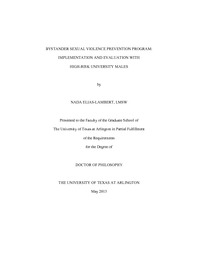
ATTENTION: The works hosted here are being migrated to a new repository that will consolidate resources, improve discoverability, and better show UTA's research impact on the global community. We will update authors as the migration progresses. Please see MavMatrix for more information.
Show simple item record
| dc.contributor.author | Elias-Lambert, Nada | en_US |
| dc.date.accessioned | 2013-07-22T20:15:26Z | |
| dc.date.available | 2013-07-22T20:15:26Z | |
| dc.date.issued | 2013-07-22 | |
| dc.date.submitted | January 2013 | en_US |
| dc.identifier.other | DISS-12091 | en_US |
| dc.identifier.uri | http://hdl.handle.net/10106/11893 | |
| dc.description.abstract | This research reports the findings of an evaluation of a theoretically-based, peer-facilitated, bystander sexual violence prevention program to determine its effectiveness at changing attitudes and behaviors related to sexual violence with university males who are at low- and high-risk of using sexually coercive behavior. Bystander interventions focus on men and women as bystanders to change social norms in a peer culture that supports abusive behaviors. Few studies have examined the effectiveness of these interventions with high-risk populations, which is the focus of this study. A bystander sexual violence prevention program was presented to 142 fraternity members in 2012. A quasi-experimental design utilizing pre-, post-, and follow-up surveys was used to compare the effectiveness of this prevention program with university males who are at low- and high-risk of using sexually coercive behavior in intervention and comparison groups. Participants' risk status was measured prior to the intervention using the Modified-Sexual Experiences Survey. The survey instruments included measures to evaluate changes in attitudes (rape myth acceptance and bystander attitudes) and behaviors (sexually coercive behaviors, sexually coercive behavioral intentions, and bystander behaviors). Data analyses included Repeated-Measures Analysis of Covariances and hierarchical multiple regressions. The findings suggest that a bystander sexual violence prevention program has a positive impact on attitudes and behaviors related to sexual violence among fraternity members, however, the program had less impact on high-risk males. Since both risk status and ethnicity predicted outcomes related to sexual violence, it is important to focus on determining the effect of programs on both high- and low-risk males and developing culturally relevant bystander interventions. The results of this study will expand our ability to design programs that can have an impact on reducing sexual violence on campus by ensuring the programs are having the desired impact on the target audience. | en_US |
| dc.description.sponsorship | Black, Beverly | en_US |
| dc.language.iso | en | en_US |
| dc.publisher | Social Work | en_US |
| dc.title | Bystander Sexual Violence Prevention Program: Implementation And Evaluation With High-risk University Males | en_US |
| dc.type | Ph.D. | en_US |
| dc.contributor.committeeChair | Black, Beverly M. | en_US |
| dc.degree.department | Social Work | en_US |
| dc.degree.discipline | Social Work | en_US |
| dc.degree.grantor | University of Texas at Arlington | en_US |
| dc.degree.level | doctoral | en_US |
| dc.degree.name | Ph.D. | en_US |
Files in this item
- Name:
- EliasLambert_uta_2502D_12091.pdf
- Size:
- 1009.Kb
- Format:
- PDF
This item appears in the following Collection(s)
Show simple item record


